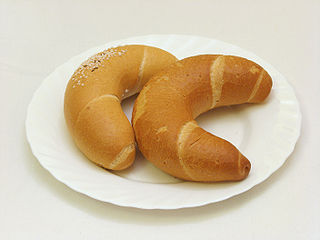
Pastry is a dough of flour, water and shortening that may be savoury or sweetened. Sweetened pastries are often described as bakers' confectionery. The word "pastries" suggests many kinds of baked products made from ingredients such as flour, sugar, milk, butter, shortening, baking powder, and eggs. Small tarts and other sweet baked products are called pastries. Common pastry dishes include pies, tarts, quiches, croissants, and pasties.

Dough is a thick, malleable, sometimes elastic paste made from grains or from leguminous or chestnut crops. Dough is typically made by mixing flour with a small amount of water or other liquid and sometimes includes yeast or other leavening agents, as well as ingredients such as fats or flavorings.

A cookie cutter in North American English, also known as a biscuit cutter outside North America, is a tool to cut out cookie/biscuit dough in a particular shape.

A peel is a shovel-like tool used by bakers to slide loaves of bread, pizzas, pastries, and other baked goods into and out of an oven. It is usually made of wood, with a flat carrying surface for holding the baked good and a handle extending from one side of that surface. Alternatively, the carrying surface may be made of sheet metal, which is attached to a wooden handle. Wood has the advantage that it does not become hot enough to burn the user's hands the way metal can, even if it is frequently in the oven. The word presumably derives from the French pelle, which describes both a peel and a shovel.

Filo or phyllo is a very thin unleavened dough used for making pastries such as baklava and börek in Middle Eastern and Balkan cuisines. Filo-based pastries are made by layering many sheets of filo brushed with oil or butter; the pastry is then baked.

Bhatoora is a fluffy deep-fried leavened sourdough bread originating from the Indian subcontinent. It is commonly served as a midday meal or a breakast dish in northern and eastern India. Paired with chickpea curry, it forms a traditional dish called chole bhature which originated in Punjab.

Kifli, kiflice, kifle or kipferl is a traditional yeast bread roll that is rolled and formed into a crescent before baking.

Banitsa also transliterated as banica and banitza) is a traditional pastry dish made in Bulgaria, North Macedonia and Serbia, prepared by layering a mixture of whisked eggs, natural yogurt and pieces of white brined cheese between filo pastry and then baking it in an oven.

In cooking, kneading is a process in the making of bread or dough, used to mix the ingredients and add strength to the final product. Its importance lies in the mixing of flour with water; when these two ingredients are combined and kneaded, the gliadin and glutenin proteins in the flour expand and form strands of gluten, which gives bread its texture. The kneading process warms and stretches these gluten strands, eventually creating a springy and elastic dough. If bread dough is not kneaded enough, it will not be able to hold the tiny pockets of gas created by the leavening agent, and will collapse, leaving a heavy and dense loaf.

Springerle is a type of South German biscuit or cookie with an embossed design made by pressing a mold onto rolled dough and allowing the impression to dry before baking. This preserves the detail of the surface pattern. While historical molds show that springerle were baked for religious holidays and secular occasions throughout the year, they are now most commonly associated with the Christmas season.
Docker or dockers often refers to:

Beaten biscuits are a Southern food from the United States, dating from the 19th century. They differ from regular American soft-dough biscuits in that they are more like hardtack. In New England they are called "sea biscuits", as they were staples aboard whaling ships. Beaten Biscuits are also historically associated with Maryland cuisine.

In cooking, proofing is a step in the preparation of yeast bread and other baked goods where the dough is allowed to rest and rise a final time before baking. During this rest period, yeast ferments the dough and produces gases, thereby leavening the dough.

Vienna bread is a type of bread that is produced from a process developed in Vienna, Austria, in the 19th century. The Vienna process used high milling of Hungarian grain, and cereal press-yeast for leavening.

A rolling pin is a cylindrical food preparation utensil used to shape and flatten dough. Two styles of rolling pin are found: rollers and rods. Roller types consists of a thick cylinder with small handles at each end; rod type rolling pins are usually thin tapered batons. Rolling pins of different styles and materials offer varying advantages, as they are used for different tasks in cooking and baking.

Kūčiukai also called Christmas cakes - is a traditional Lithuanian dish served on Kūčios, the traditional Christmas Eve dinner in Lithuania. They are small, slightly sweet pastries made from leavened dough and poppy seeds. There are variations in sweetness, it is usually eaten dry but can be served soaked in poppy milk or with cranberry kissel. Initially they were made as small loaves of bread served for the spirits - vėlės.

Speķrauši, speķa rauši, speķa pīrāgi or speķa pīrādziņi, sometimes also colloquially called simply pīrāgi or pīrādziņi is an oblong or crescent-shaped baked Latvian bread roll or pastry, often containing a filling of finely chopped bacon cubes and onion. Speķrauši range from five to thirteen centimetres in length, depending on if they are intended as a snack or a more substantial meal. Smaller speķrauši are often prized for their daintiness and are considered the work of a skilled cook.

A tahini roll or tahini bread roll is a sweet pastry found commonly in the cuisines of Armenia as Թահինով Հաց; Cyprus and Greece as ταχινόπιττα or τασιηνόπιττα; Turkey as tahinli çörek; and in Arab cuisine as khubz tahini. They are a popular street food in Cyprus.

















